Whortleberry may refer to the berries of several plants of genus Vaccinium :
- Vaccinium myrtillus , European bilberry or blue whortleberry
- Vaccinium vitis-idaea , lingonberry or red whortleberry
- Vaccinium uliginosum , bog whortleberry/bilberry
Whortleberry may refer to the berries of several plants of genus Vaccinium :

Vaccinium is a common and widespread genus of shrubs or dwarf shrubs in the heath family (Ericaceae). The fruits of many species are eaten by humans and some are of commercial importance, including the cranberry, blueberry, bilberry (whortleberry), lingonberry (cowberry), and huckleberry. Like many other ericaceous plants, they are generally restricted to acidic soils.
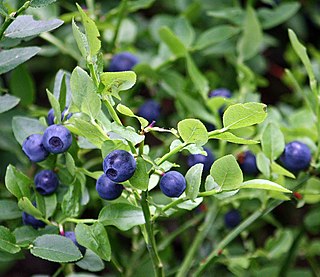
Bilberries, or sometimes European blueberries, are a primarily Eurasian species of low-growing shrubs in the genus Vaccinium, bearing edible, dark blue berries. The species most often referred to is Vaccinium myrtillus L., but there are several other closely related species.
Wineberry may refer to the following plants:
Bilberry may also refer to:
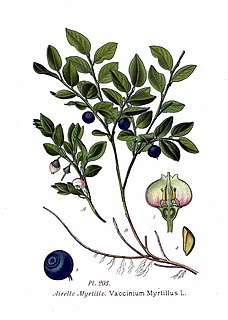
Vaccinium myrtillus or European blueberry is a holarctic species of shrub with edible fruit of blue color, known by the common names bilberry, blaeberry, wimberry, and whortleberry. It is more precisely called common bilberry or blue whortleberry to distinguish it from other Vaccinium relatives.

Vaccinium uliginosum is a Eurasian and North American flowering plant in the genus Vaccinium within the heath family.
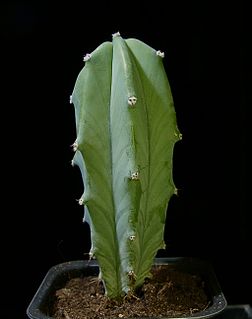
Myrtillocactus geometrizans is a species of cactus in the genus Myrtillocactus, native to central and northern Mexico.
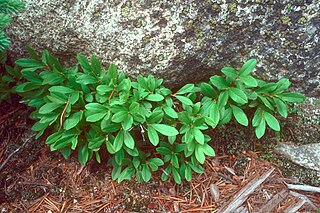
Vaccinium cespitosum, known as the dwarf bilberry, dwarf blueberry, or dwarf huckleberry, is a species of flowering shrub in the genus Vaccinium, which includes blueberries, huckleberries, and cranberries.

Blåbärssoppa or blueberry soup is a Nordic soup made from bilberries, which can be served cold or hot. It is sweet and contains starch, which gives it a fairly thick consistency. It is served either as soup, often together with porridge, or as a drink.
"Blue huckleberry" refers to either of two plants native to North America:
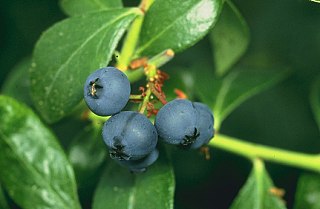
Blueberries are a widely distributed and widespread group of perennial flowering plants with blue or purple berries. They are classified in the section Cyanococcus within the genus Vaccinium. Vaccinium also includes cranberries, bilberries, huckleberries and Madeira blueberries. Commercial blueberries—both wild (lowbush) and cultivated (highbush)—are all native to North America. The highbush varieties were introduced into Europe during the 1930s.

Huckleberry is a name used in North America for several plants in the family Ericaceae, in two closely related genera: Vaccinium and Gaylussacia. The huckleberry is the state fruit of Idaho.

Vaccinium caesariense is native to the Eastern United States. It is a species in the genus Vaccinium, which includes blueberries, cranberries, huckleberry, and bilberries.

Vaccinium deliciosum is a species of bilberry known by the common names Cascade bilberry, Cascade blueberry, and blueleaf huckleberry.
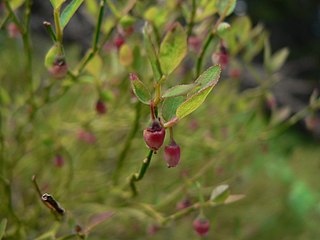
Vaccinium scoparium is a species of huckleberry known by the common names grouse whortleberry, grouseberry, and littleleaf huckleberry.

Vaccinium praestans or Vaccinium praestans - Lamb. or Kamchatka bilberry, is a perennial shrub in the family Ericaceae, which includes species like cranberries, blueberries, and huckleberries. In Russia this plant is known as the Klopovka, or stink-bug berry, due to its distinct, potent scent, resembling that of a secretion produced by bugs of Heteroptera genus. The plant is native to Kamchatka but can be found in North America to Eastern Asia. Mostly growing in the wild, it is also enjoyed as an ornamental plant, most commonly in Japan, where it is used to decorate home gardens. Like many other species in the family Ericaceae, its berries are edible.
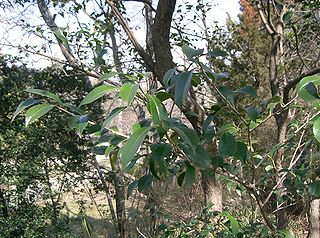
Vaccinium bracteatum, the sea bilberry or Asiatic bilberry, is a species of Vaccinium native to Japan, the Ryukyu Islands, Korea, southeast and south central China, Hainan, Taiwan, mainland Southeast Asia, Java, and Sumatra. It is a small tree or large shrub, with dark purple edible fruit. It is in semi-cultivation in China. Local people collect and consume the fruit, and in addition extract a bluish-violet dye from the leaves, which is used as a hair dye, for coloring vinegar, and in cooking. The dye turns black when cooked with rice, providing culinary interest.